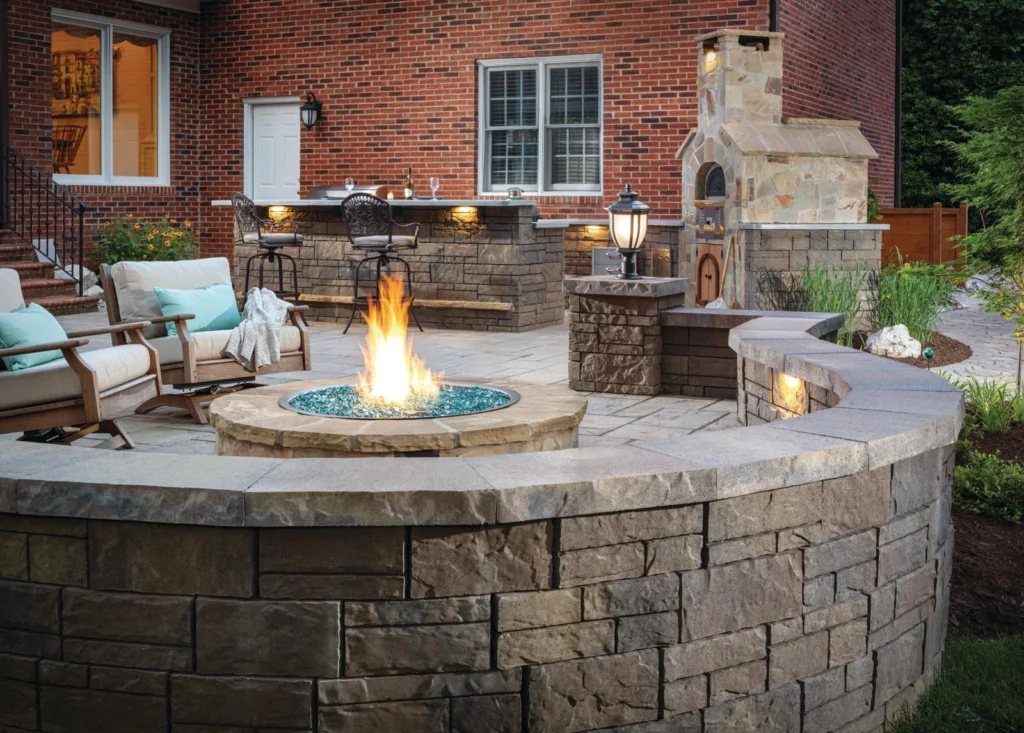What is a Fire Pit?
A fire pit is an outdoor heating source that is designed to provide warmth and light for those who enjoy spending time outdoors. Fire pits are typically made from non-combustible materials, such as concrete blocks, bricks, or stone, which make them a safe and durable option for outdoor use.
There are several types of fire pits available, ranging from wood-burning to gas-powered designs. Wood-burning fire pits are the traditional option and require fuel in the form of firewood or charcoal. These types of fire pits produce a cozy, crackling flame and offer the added benefit of a rustic scent that many people enjoy.
Gas-powered fire pits, on the other hand, are becoming increasingly popular due to their convenience and ease of use. Gas-fueled fire pits run on either propane or natural gas and can be turned on and off with the flip of a switch. These fire pits offer the same warm glow as wood-burning designs, but without the need for firewood or charcoal.
Overall, fire pits are a great addition to any outdoor living space and can provide a cozy, intimate space for friends and family to gather around. However, it is important to consider proper ventilation, safe fuel sources, and proper precautions, such as having a bucket of water nearby, to ensure a safe and enjoyable experience.
Benefits of Having a Fire Pit on Your Patio
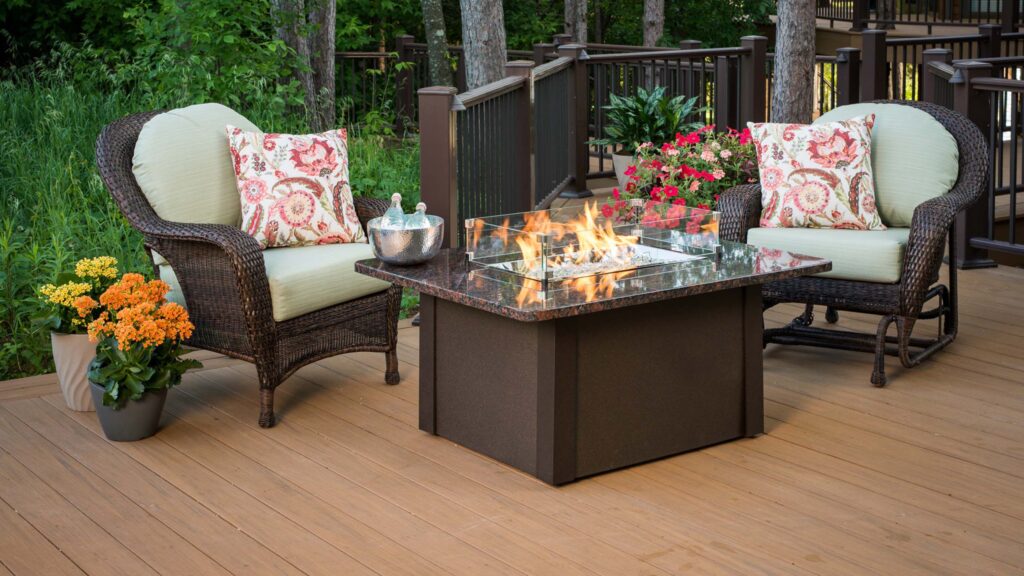
There’s something magical about gathering around a cozy fire on a cool evening, and having a fire pit on your patio can bring that magic right to your doorstep. Not only do fire pits add ambiance and warmth to your outdoor living space, but they also offer a variety of other benefits.
First and foremost, fire pits create an intimate space for socializing and relaxing. Whether you’re hosting a party or just enjoying a quiet evening with loved ones, a fire pit is the perfect centerpiece for any outdoor gathering. You can even cook over the flames, making it a great addition to any backyard BBQ or cookout.
Another benefit of having a fire pit on your patio is the radiant heat it provides. As the flames dance and flicker, they emit a comforting warmth that can take the chill out of even the coldest nights. This can extend the use of your outdoor living space well into the fall and winter months, allowing you to enjoy your patio year-round.
Additionally, fire pits can add value to your home. A well-designed and properly installed fire pit can be a unique feature that sets your home apart from others on the market. It can also make your outdoor space more attractive and desirable to potential homebuyers.
Of course, there are some safety concerns to keep in mind when installing a fire pit on your patio. Be sure to choose a non-combustible surface, such as concrete or stone, and keep the fire pit away from any flammable materials. Always follow proper precautions, such as keeping a bucket of water nearby and ensuring proper ventilation.
In conclusion, a fire pit on your patio can offer a variety of benefits, from creating an intimate social space to providing radiant heat on cool nights. It can even add value to your home. With the proper precautions and safety measures in place, a fire pit can be a safe and enjoyable addition to any outdoor living space.
Types of Fire Pits
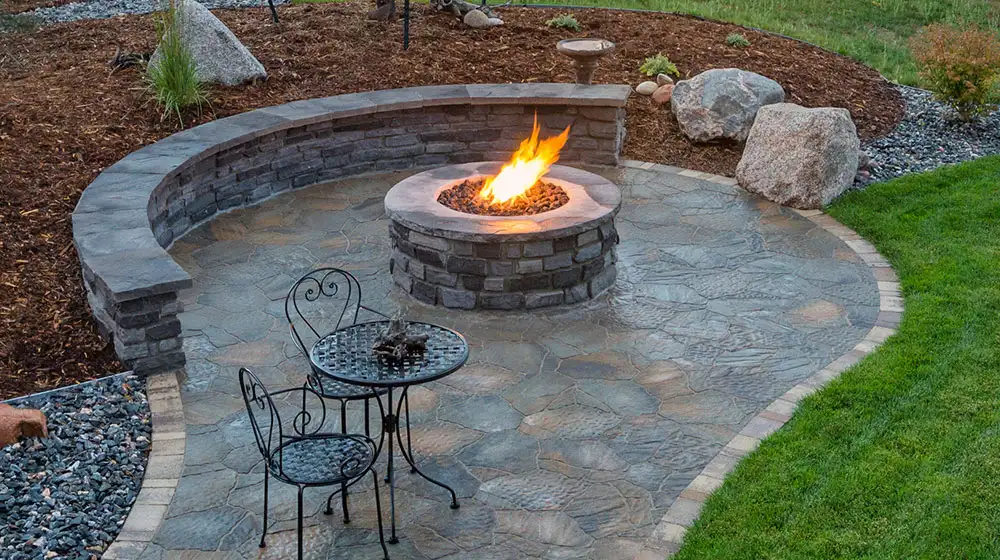
A fire pit can add a warm and inviting touch to any outdoor living space. But with so many different types of fire pits on the market, it can be difficult to choose the right one for your needs. Here are some of the most popular types of fire pits available to help you make an informed decision.
1. Wood-Burning Fire Pits: These traditional fire pits are fueled by wood and provide a natural flame that crackles and pops. They are perfect for creating a rustic and nostalgic atmosphere in your backyard. However, they require extra precautions, such as ensuring proper ventilation and keeping a bucket of water nearby.
2. Gas Fire Pits: These fire pits are fueled by propane or natural gas and require minimal maintenance. They provide a clean-burning and smokeless flame that is easy to control with the flip of a switch. They are great for those who want a hassle-free option for their outdoor space.
3. Portable Fire Pits: As the name suggests, these fire pits are lightweight and easy to move around. They can be fueled by wood or gas, making them versatile options for any outdoor living space. They are ideal for those who want the flexibility to move their fire pit around, depending on the occasion.
4. DIY Fire Pits: For those who are handy with tools, building a fire pit from scratch can be a satisfying project. From stacked stone to repurposed materials, there are countless options for creating a unique and personalized fire pit. However, extra caution and attention to safety measures is required.
5. Tabletop Fire Pits: These smaller-scale fire pits are perfect for those who have limited space or want to add a cozy touch to their dining table. They can be fueled by propane or gel fuel and come in a variety of styles and designs to match any decor.
Whatever type of fire pit you choose, always remember to follow proper safety precautions and use caution when operating it. With the right fire pit, you can enhance your outdoor living space and create a warm and inviting atmosphere for all to enjoy.
Wood-Burning Fire Pits
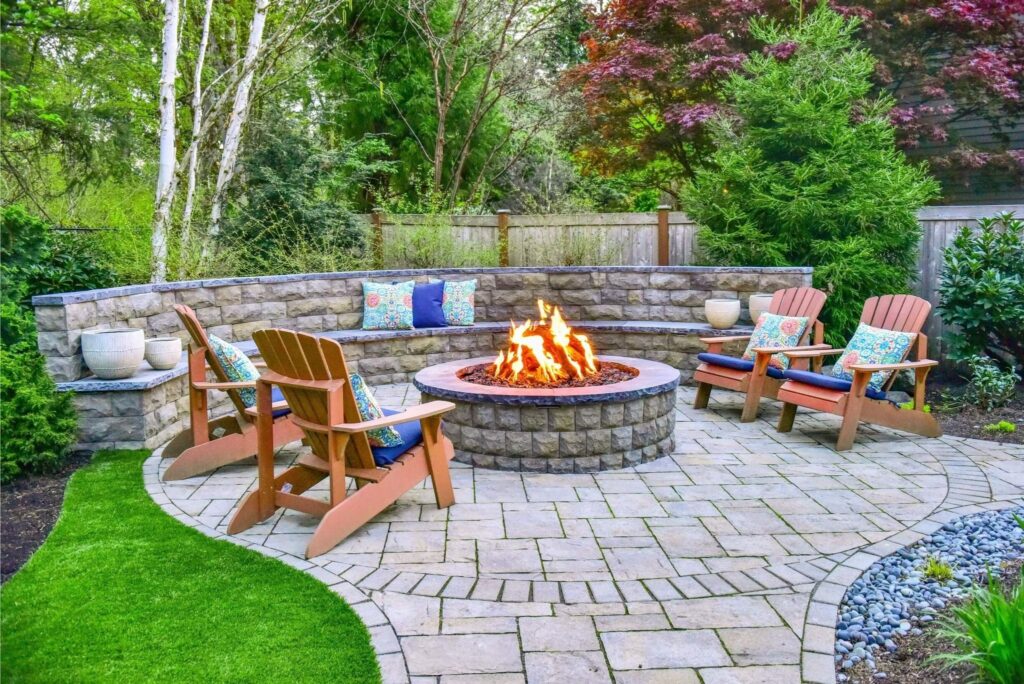
Wood-burning fire pits are classic additions to any backyard. They create a warm and cozy atmosphere that is perfect for roasting marshmallows, catching up with friends and family, or simply unwinding after a long day. However, before adding a wood-burning fire pit to your outdoor space, it’s important to take certain precautions and understand the potential risks.
One of the biggest risks associated with wood-burning fire pits is the potential for fire. Wood fires can spread quickly and cause significant damage to your property, neighboring homes, and even surrounding forests. It’s important to make sure that your fire pit is located away from any flammable materials, such as wooden decks or patio covers. If your patio is made of wood or other combustible materials, it’s best to place your fire pit on a non-combustible surface, such as concrete pavers or a concrete patio.
Another risk associated with wood-burning fire pits is the potential for heat damage. Fire pits can generate a significant amount of radiant heat, which can cause damage to deck surfaces or other nearby objects. To prevent this, it’s important to make sure that your fire pit is placed on a level surface, and that there is plenty of clearance around it. You should also make sure that there is proper ventilation to allow for adequate air flow and prevent the buildup of carbon monoxide.
In addition to these safety precautions, it’s important to always practice proper fire safety when using a wood-burning fire pit. This includes keeping a bucket of water nearby in case of emergency, never leaving a fire unattended, and avoiding the use of lighter fluid or other accelerants to start your fire. It’s also important to familiarize yourself with any building codes or regulations in your area that might govern the use of fire pits.
Despite these potential risks, wood-burning fire pits can be a great addition to your outdoor living space. They provide a natural and rustic atmosphere that is hard to replicate with other types of fire pits. With the proper precautions and attention to safety measures, you can safely enjoy all the warmth and coziness that a wood-burning fire pit has to offer.
Gas Fire Pits

Gas fire pits are a popular option for those who want to enjoy the warmth and ambiance of a fire without the hassle and mess of a wood fire. They come in a variety of sizes and designs, from circular to rectangular, and can be fueled by natural gas or propane.
One of the main advantages of a gas fire pit is its convenience. With a flip of a switch or a push of a button, you can have an instant flame without the need for kindling or matches. Plus, there is no need to worry about cleaning up ash or emptying out the fire pit after use.
Another advantage is the versatility in fuel options. Natural gas can be hooked up to an existing gas line, providing a continuous supply of fuel. Propane tanks, on the other hand, offer the flexibility of a portable fire pit that can be moved around your outdoor living space.
Gas fire pits are also a safer option than wood-burning fire pits. Since there is no actual burning of wood, there is no risk of embers or sparks flying out of the fire pit and igniting surrounding materials. Plus, since the flame can be easily controlled, there is less risk of fires getting out of hand.
When it comes to design, gas fire pits offer a sleek and modern look that can complement any outdoor living space. They can be made from a variety of materials such as metal, stone, or concrete and can be customized to fit your style and preferences.
However, it’s important to note that gas fire pits still require proper safety precautions. Make sure to place your fire pit on a non-combustible surface and keep the area around it clear of any flammable materials. Always read the manufacturer’s instructions and familiarize yourself with any gas lines or propane tanks used to fuel your fire pit.
Overall, gas fire pits offer a convenient and beautiful way to enjoy the warmth of a fire in your outdoor living space. With proper care and safety measures, they can be a safe and enjoyable addition to any backyard.
Portable Fire Pits
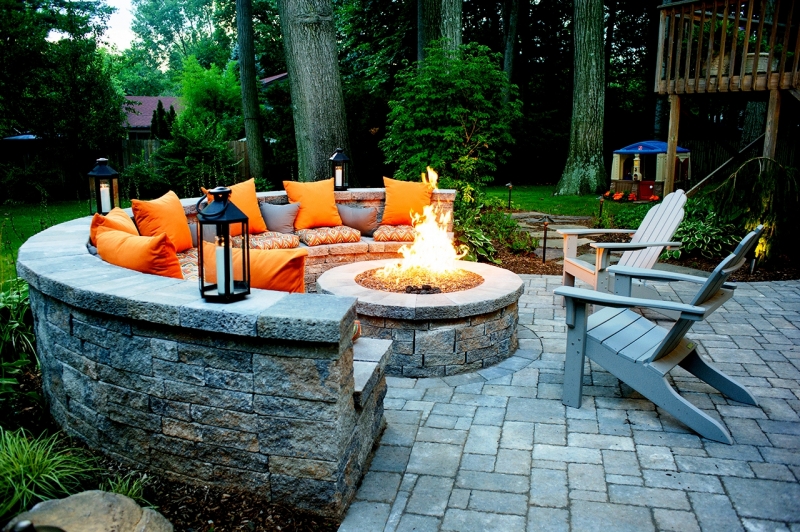
Portable fire pits are an increasingly popular addition to outdoor living spaces due to their convenience and versatility. With a portable fire pit, you can enjoy the warmth and ambiance of a fire without the commitment of a permanent installation. Here are some things to consider when choosing and using a portable fire pit.
Firstly, it is essential to choose a fire pit that is safe and well-designed. Look for fire pits that are made from high-quality materials and meet safety standards in your area. Consider the size and style of the fire pit, as well as its fuel source. Common fuel sources for portable fire pits include wood, propane, and natural gas.
When selecting a fuel source, keep in mind the availability and cost of fuel in your area, as well as the level of heat output and convenience. For example, wood-burning fire pits provide a traditional campfire feel but require a steady supply of wood and are less convenient to start and maintain than gas-powered fire pits.
Another crucial factor to consider is where to set up your portable fire pit. Always choose a level and stable surface that is at least 10 feet away from any flammable materials, such as trees, plants, or buildings. Check with local regulations to ensure you are selecting an area that is allowed for fires.
When using your portable fire pit, take safety precautions seriously, just as you would with any outdoor fire. Always have a bucket of water or a fire extinguisher nearby and never leave the fire pit unattended. Ensure all fires are fully extinguished before leaving the area or going to bed.
In conclusion, a portable fire pit is a fantastic addition to any outdoor living space, providing warmth, ambiance, and a cozy gathering spot for family and friends. However, it is crucial to select a fire pit that meets safety standards, choose an appropriate fuel source, and follow proper safety precautions when using it. With these tips in mind, you can enjoy your portable fire pit safely and comfortably for years to come.
Deck Fire Pits
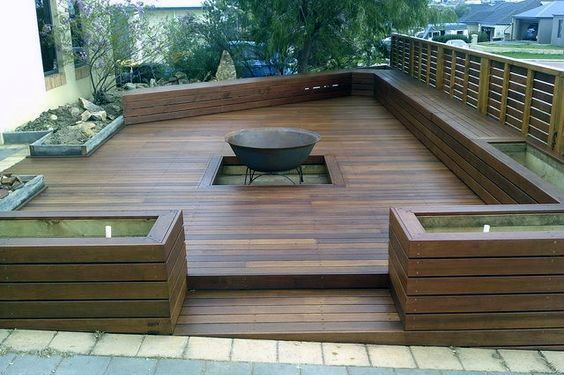
Deck fire pits are a popular addition to many outdoor living spaces, allowing you to enjoy the warmth and ambiance of a fire without leaving your backyard. However, before installing a fire pit on your deck, it is crucial to understand the potential risks and take steps to ensure safety.
One of the primary concerns with deck fire pits is the risk of heat damage to your deck surface. This can happen with any type of fire pit, but it is especially important to consider with wood-burning fire pits, which can emit sparks and flying embers that can damage or ignite your deck. To prevent this, it is crucial to place your fire pit on a non-combustible material, such as concrete blocks or pavers.
Another important consideration is proper ventilation. Gas-fueled fire pits produce less smoke and require less ventilation than wood-burning fire pits, making them a safer choice for deck use. However, it is still important to ensure that there is enough ventilation to prevent the buildup of toxic gases.
When purchasing a deck fire pit, it is also essential to choose one that is the appropriate size for your space. A fire pit that is too large can create a dangerous level of heat and pose a risk of fire or damage to your home or surrounding structures. On the other hand, a fire pit that is too small may not provide enough warmth and could be a less enjoyable addition to your outdoor living space.
Finally, it is crucial to follow all local building codes and regulations when installing a deck fire pit. These regulations may dictate the type of fuel, placement, and other safety measures required for your specific area. Make sure to also follow any manufacturer recommendations and instructions for use and maintenance.
Overall, with the right precautions and considerations, deck fire pits can be a safe and enjoyable addition to any outdoor living space. Just remember to prioritize safety and take steps to prevent fire and heat damage to your deck and home.
Metal Fire Pits

Metal fire pits are a popular choice for outdoor living spaces. They come in a variety of shapes, sizes, and designs, and can create a warm and inviting ambiance for gatherings and relaxation.
One of the benefits of metal fire pits is their durability. They are made from materials such as steel, cast iron, and copper, which can withstand extreme heat and weather conditions. This means that they can last for many years with proper care and maintenance.
Another advantage of metal fire pits is their ease of use. They can be fueled by wood, charcoal, or gas, depending on the design. Wood and charcoal-fueled fire pits offer a classic and traditional experience, while gas-powered fire pits offer a more convenient and low maintenance option.
Metal fire pits are also versatile in design. They can come in shapes such as round, square, and rectangular, and can be adorned with decorative elements such as cut-out patterns or intricate designs. Some metal fire pits are also portable, making them a great option for those who want to move their fire pit around or take it with them on camping trips.
However, it is important to take proper safety precautions when using a metal fire pit. This includes placing the fire pit on a level surface, away from flammable materials such as plants, furniture, and structures. It is also important to have a bucket of water or a fire extinguisher nearby in case of an emergency.
In conclusion, metal fire pits offer a durable and versatile option for creating a warm and inviting outdoor living space. They offer a range of design options, fuel choices, and portability, and can offer years of enjoyment with proper care and safety measures in place.
Safety Precautions for Using a Fire Pit on Your Patio
When it comes to adding a fire pit to your patio, there are many benefits to consider. A fire pit can create a cozy and intimate space for outdoor gatherings, and can even increase the value of your home. However, it is important to take proper safety precautions when using a fire pit, as they can pose potential risks if not used correctly. Here are some safety measures to keep in mind when using a fire pit on your patio.
First and foremost, it is crucial to place your fire pit on a level surface. This will ensure that it remains stable and does not tip over during use, which could start a fire or cause injury. If your patio has an uneven surface, it may be necessary to lay down concrete blocks or pavers to create a level area for your fire pit.
Another key safety measure is to ensure that your fire pit is located at a safe distance from any flammable materials. This includes plants, furniture, structures, and even your home itself. It is recommended to have a minimum clearance of 10 feet between your fire pit and any surrounding objects. This will help prevent accidental fires.
It is also important to consider the type of fire pit you are using. If you opt for a wood-burning fire pit, be sure to use only dry, seasoned wood and avoid using lighter fluid or other accelerants. When starting a fire, use kindling or a fire starter to avoid sudden flare-ups. If you prefer a gas-powered fire pit, ensure that all gas lines and connections are properly installed and maintained by a professional.
It is always a good idea to have a bucket of water or a fire extinguisher nearby in case of an emergency. This will allow you to quickly and safely extinguish any fires that may start unexpectedly. Additionally, it is important to monitor your fire pit at all times while it is in use, especially if children or pets are present. Keep a close eye on the flames and avoid leaving your fire pit unattended.
Lastly, it is important to consider the materials used in your patio construction. If you have a wooden deck or other combustible materials in your outdoor space, take extra care when using a fire pit. Consider using a non-combustible material such as concrete for your patio surface. This will help prevent heat damage and reduce the risk of accidental fires.
In summary, using a fire pit on your patio can be a great way to create a cozy and inviting outdoor space. However, it is important to prioritize safety and take the necessary precautions to avoid potential risks. By following these safety guidelines, you can enjoy your fire pit with peace of mind.
Flammable and Combustible Materials
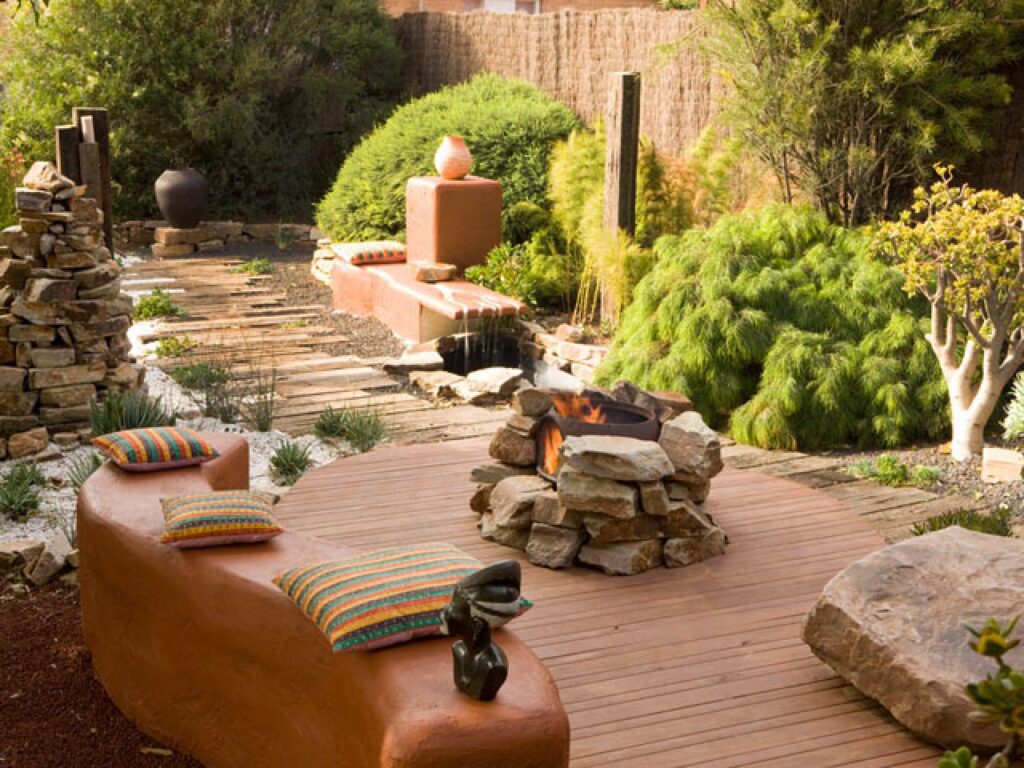
Flammable and combustible materials are two types of substances commonly found in many industries and settings. These materials are highly dangerous and can lead to catastrophic accidents, fires, and even explosions when not handled with proper care and caution. It is therefore important to understand the differences between flammable and combustible materials, as well as the necessary safety measures that should be taken when handling them.
Flammable materials are substances that can easily ignite and quickly spread fire. These materials have a flash point – the lowest temperature at which they can ignite – below 100°F. Some common examples of flammable materials include gasoline, alcohol, propane, and many types of solvents and chemicals. Flammable materials should be stored in approved containers and away from heat sources, sparks, or flames. Smoking should also be strictly prohibited in areas where these materials are present.
On the other hand, combustible materials are substances that burn slowly and require more heat to ignite. These materials have a flash point above 100°F but below 200°F. Common examples of combustible materials include wood, paper, and certain plastics. While combustible materials are less prone to ignition, they can still start fires when exposed to high temperatures or open flames. Proper storage and handling of combustible materials is critical to preventing fires and reducing the risk of accidents.
When working with flammable or combustible materials, it is essential to follow proper safety precautions. This includes using personal protective equipment such as gloves, goggles, and respirators, as well as ensuring adequate ventilation in work areas. Smoking should never be allowed near these materials, and any potential ignition sources such as faulty electrical equipment or overheating machinery should be promptly fixed or replaced.
By following these safety measures and understanding the potential hazards of flammable and combustible materials, individuals and organizations can minimize the risk of accidents, injuries, and property damage. It is crucial to always prioritize safety and take every precaution when working with these hazardous substances.
Proper Ventilation for the Area
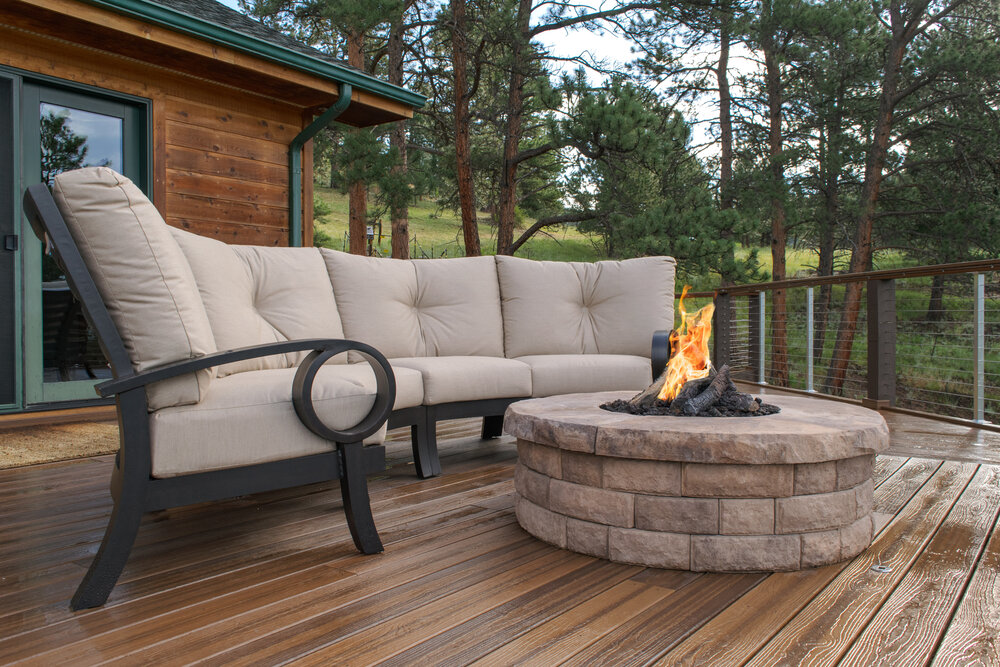
Proper ventilation is crucial when it comes to setting up a fire pit on your patio. Without proper ventilation, the area can quickly fill up with smoke, making it uncomfortable for you and potentially dangerous for your health. There are several things you can do to ensure that your patio is properly ventilated when using a fire pit.
First and foremost, make sure that the area around your fire pit is free of any obstructions. This means moving any furniture, plants, or other objects away from the fire pit so that air can freely flow around it. You should also avoid using your fire pit in enclosed or covered areas, as this can cause smoke to trap and build up inside the space.
Next, consider the direction of the wind in your area. If the wind is blowing in a certain direction, you may want to position your fire pit in a way that allows the smoke to be carried away from your patio and not towards your home or neighbors.
Additionally, you can invest in outdoor fans or create openings in any nearby walls or fences to help improve airflow around your patio. This can help disperse the smoke and make your outdoor space more pleasant for you and your guests.
Finally, always keep a bucket of water nearby when using a fire pit, just in case the flames get out of control. This can help prevent any accidental fires and ensure that you and your patio stay safe.
Overall, proper ventilation is essential when using a fire pit on your patio. By taking a few simple steps, you can create a safe and comfortable outdoor living space that allows you to enjoy your fire pit to the fullest.
Properly Storing Fuel Sources (Propane Tank)
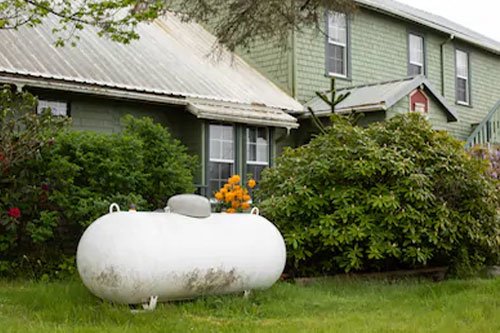
When it comes to setting up and using a propane fire pit, it’s important to understand the proper storage and handling of the fuel source – the propane tank. Whether you’re a first-time owner or a seasoned user, it’s crucial to follow these guidelines for storing your propane tank to ensure maximum safety and longevity.
First, before even purchasing your propane tank, be sure to choose one that has been certified by an independent testing agency, such as Underwriters Laboratories (UL). This certification serves as a guarantee that the tank meets safety and quality standards and has been tested for leaks and other potential hazards.
Next, when you bring your tank home, it’s important to keep it in a cool, dry and well-ventilated area. This means avoiding direct sunlight and areas with extreme heat and humidity. You should also never store your propane tank indoors, including in your garage or basement. In the event of a leak, propane can quickly accumulate and pose a serious safety risk.
When it comes to transporting your propane tank, always use caution and follow proper safety measures. Be sure to securely fasten the tank in an upright position to prevent it from moving or tipping over in your vehicle.
Additionally, always check your tank for any signs of damage or wear and tear before use. This can include cracks, dents, or corrosion on the valve or tank itself. If you notice any of these signs or suspect a gas leak, do not attempt to use the tank – immediately contact a professional.
By following these guidelines for proper propane tank storage and handling, you can ensure the safety of yourself, your family, and your outdoor living space. Remember, safety always comes first – so never cut corners when it comes to handling fuel sources for your outdoor fire pit.
Always Have a Bucket of Water Nearby
Whenever you’re working with fire, it’s important to be prepared for any potential accidents or mishaps. One simple but effective way to ensure your safety is to always have a bucket of water nearby.
Whether you’re using a wood-burning fire pit, a gas-powered fire pit, or even a homemade fire pit, things can sometimes go wrong. Sparks may fly out of the pit, embers and debris may fall onto the ground, or the fire may get out of control. In any of these scenarios, having a ready source of water can make all the difference.
A bucket of water can be used to quickly extinguish any small fires that may start. It can also be used to douse any hot coals or embers that may fall onto nearby flammable materials, such as leaves or grass. In the event of an emergency, having water within reach can help prevent a major disaster.
However, it’s not just enough to simply have a bucket of water nearby. You should also know how to use it properly. This means knowing where the bucket is at all times, as well as how to quickly access it in case of an emergency. You should also make sure that the bucket is filled with enough water to be effective, and that it’s within reach of all those who might be using the fire pit.
In addition to a bucket of water, it’s also a good idea to have other fire safety tools nearby. This can include a fire extinguisher, a fire blanket, and a first aid kit. By taking these precautions and being prepared, you can enjoy the warmth and comfort of a fire pit while also staying safe and aware.
Follow Local Building Codes
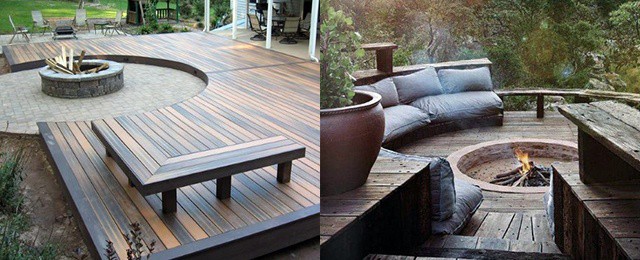
When considering adding a fire pit to your patio or outdoor living space, it’s important to follow local building codes and regulations. Building codes vary from location to location, and failing to adhere to them can result in fines or even legal issues.
One important factor to consider is the type of fire pit you plan to install. Wood-burning fire pits may be prohibited in certain areas due to air quality concerns, while gas-powered fire pits may require permits or inspections to ensure proper installation and safe usage.
Another consideration is the placement of the fire pit. Many building codes require a certain distance between the fire pit and any nearby structures, such as a patio cover or wooden deck. This is to avoid potential heat damage or fire hazards.
In addition, the materials used for the fire pit itself and its surroundings matter. Flammable materials such as wooden decks or composite decking may not be suitable for a fire pit, whereas non-combustible materials such as concrete pavers or a concrete patio may be a better option.
Proper ventilation is also essential when installing a fire pit, as the combustion process produces carbon monoxide and other potentially harmful gases. This means that enclosed areas such as covered patios may not be suitable for a fire pit unless proper ventilation is established.
In summary, before installing a fire pit on your patio or outdoor living space, it’s crucial to research and follow local building codes and regulations. This ensures not only a safe and enjoyable experience for you and your loved ones, but peace of mind knowing that you are complying with the law and avoiding any potential legal issues.
Placement Considerations for Your Patio’s Fire Pit
A fire pit is a great addition to any patio, providing warmth and ambiance for outdoor gatherings and events. However, when it comes to installing a fire pit on your patio, there are several placement considerations that need to be taken into account.
First and foremost, it’s important to consider the proximity of the fire pit to any structures on your patio. This includes your home, any patio covers or awnings, and any nearby trees or bushes. Keep in mind that a fire pit produces radiant heat that can easily ignite nearby objects or structures. As a general rule of thumb, a fire pit should be situated at least 10 feet away from any flammable item.
Another placement consideration is the ground surface of your patio. If you have a wooden deck or a surface made of other flammable materials, you may need to reconsider installing a fire pit altogether. Similarly, if you have a concrete or stone patio, you’ll need to make sure that the surface is level and stable to prevent the fire pit from tipping over.
In addition, you’ll need to consider the size and shape of your fire pit. Some fire pit designs, such as rectangular or circular shapes, may be more suitable for certain patio layouts or configurations. You’ll also need to make sure that your fire pit is appropriately sized for your outdoor space and any local building codes or regulations.
Finally, it’s important to think about safety precautions when installing a fire pit on your patio. Make sure to have a bucket of water or a fire extinguisher on hand at all times in case of emergency. If you’re using a wood-burning fire pit, avoid using lighter fluid or accelerants that can cause flare ups or other safety hazards. If you’re using a gas fire pit, make sure to properly set up and maintain any gas lines or propane tanks as recommended by the manufacturer.
With these placement considerations in mind, you can enjoy your fire pit on your patio with safety and peace of mind.

